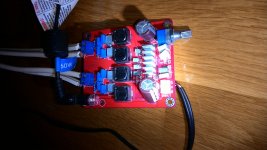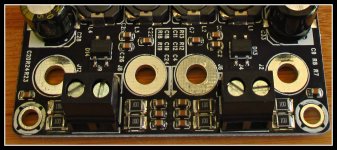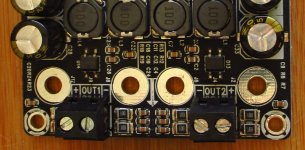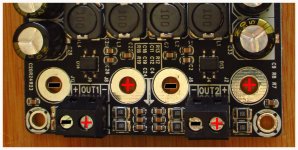Perhaps you can scrape away a bit of the trace leading to the bootstrap cap and solder a small bit of wire to connect the bootstrap cap lead to the trace.
However, it is an easy fix if you can scrape away some varnish on a trace leading from the pin on the chip and attach a cap to it. If you don't have much trace to attach a large cap, use a small SMT x7r one to keep the mass of the attached cap small and reduce stress on little solder trace. Don't throw board away it is very salvageable as long as chip is not damaged.
You guys are geniuses! Removed the old cap and used a new one just in case. Much to my chagrin, I found the other solder pad was also compromised. I had to scrape a little varnish from two traces (the one that leads to the chip and the other to the inductor) and essentially use the through hole cap as a SMT, which had to be contorted in the most unusual way to follow the traces. I had zero confidence it would work, but voila, the thing plays music! I would snap a picture but I am a little embarrassed of my work. Even with my tiny conical tip, there is more solder on the PCB than I would like, but who cares at this point? Or should I worry?
Doctor J, my hole amp is constructed with scraped of varnish and too large solderings haha.
The varnish is a really good insulator for a mere 25V. If you are going to move the amp a lot I suggest you drip a drop of epoxy on it to fasten way too big components/or poor traces.
Rhing, you won't regret doing the snubber mod! I would also suggest you try the film surface mounted capacitors for the bootstrap upgrade. I think they are even better than the XR7s! I added an eBay link a couple of pages ago🙂 Just remember to solder them in pairs if you cant find a 200nF version of them.
The varnish is a really good insulator for a mere 25V. If you are going to move the amp a lot I suggest you drip a drop of epoxy on it to fasten way too big components/or poor traces.
Rhing, you won't regret doing the snubber mod! I would also suggest you try the film surface mounted capacitors for the bootstrap upgrade. I think they are even better than the XR7s! I added an eBay link a couple of pages ago🙂 Just remember to solder them in pairs if you cant find a 200nF version of them.
You guys are geniuses! Removed the old cap and used a new one just in case. Much to my chagrin, I found the other solder pad was also compromised. I had to scrape a little varnish from two traces (the one that leads to the chip and the other to the inductor) and essentially use the through hole cap as a SMT, which had to be contorted in the most unusual way to follow the traces. I had zero confidence it would work, but voila, the thing plays music! I would snap a picture but I am a little embarrassed of my work. Even with my tiny conical tip, there is more solder on the PCB than I would like, but who cares at this point? Or should I worry?
I knew it could be saved! The TPA3116D2 is essentially bulletproof - as long as the critical parts connected are good you have music. Congrats!

Output legend on TPA3110 from sure is correct.
So did Sure use the -input of the lower channel as the +input in order to flip the phase of the output? Normally it is +,-,+,- from top down.
The CineMag CMLI-15/15B transformers with 3/8" threaded bushings for mounting cost $109.84 USD plus shipping from Canoga Park, CA.
Ouch! That's a pretty penny. Given that the name is Cinemag and it is in Canoga Park these are probably made for the movie industry - like transformers on a Panavision cine camera. No wonder they are pricey. How did you end up choosing these?
I spec'd a unit that may do the trick for $31. I was going to try this next for my to are amp.
Edcor UMM-9:
https://www.edcorusa.com/umm-9pc
Last edited:
Rhing, you won't regret doing the snubber mod! I would also suggest you try the film surface mounted capacitors for the bootstrap upgrade. I think they are even better than the XR7s! I added an eBay link a couple of pages ago🙂 Just remember to solder them in pairs if you cant find a 200nF version of them.
I definitely will give the bootstrap snubber mod a try.
For the film surface mounted caps, you mean to say they are SMD caps? The YJ board has thru-hole mounted caps, so I am not sure SMD caps would even bridge the 3mm or so of lead spacing. Can you please share a photo of how these are mounted?
If anything, I can mod my SMSL SA-36A Pro TPA3118 amp with the film surface mounted caps on the snubbers. I have a Metcal SMD soldering station with the heated tweezers.
Yes they are smd. On YJ red you have to be a bit creative to make them fit, but on YJ black I belive they would fit over the original holes🙂 On the black I have have the snubber underneath the amp. Remember that the varnish is an insulator, it lets you make larger soldering points. Do not expose the film smd for more than 350degrees celsius (absolutemax!) They are not as bulletproof as ceramics, but I think they are worth it! With them you can max out the amp without hearing artifacts in the sound!(The THD is still there of course).
Attachments
Last edited:
Well reading around, Sure's are puzzling. They use bridge rectifiers in output to.....???
Both positive and negative output AC from tpachip become input AC for bridge rectifier to become ......??? And the negative speakerterminals are grounded I saw mentioned over on another forum ??? Like single ended amplifiers ??? What would be the benefit ?
Both positive and negative output AC from tpachip become input AC for bridge rectifier to become ......??? And the negative speakerterminals are grounded I saw mentioned over on another forum ??? Like single ended amplifiers ??? What would be the benefit ?
Well reading around, Sure's are puzzling. They use bridge rectifiers in output to.....???
Both positive and negative output AC from tpachip become input AC for bridge rectifier to become ......??? And the negative speakerterminals are grounded I saw mentioned over on another forum ??? Like single ended amplifiers ??? What would be the benefit ?
Is that what the 4 lead diode package is? Hmm... SE output may let you use this like a conventional class AB amp and allow a common ground for 3 wire speaker connections to stereo. Also lets you tie channels together for matrixed stereo. If it works it may actually be very cool. This would explain the reason why + and - are mirror imaged.
Well reading around, Sure's are puzzling. ........And the negative speakerterminals are grounded I saw mentioned over on another forum ??? Like single ended amplifiers ??? What would be the benefit ?
Is that what the 4 lead diode package is? Hmm... SE output may let you use this like a conventional class AB amp and allow a common ground for 3 wire speaker connections to stereo. Also lets you tie channels together for matrixed stereo. If it works it may actually be very cool. This would explain the reason why + and - are mirror imaged.
Looking at the Sure 3116 output would lead one to think that the negative terminals are the center pair and that they are grounded but they are neither. The outputs are still BTL and each terminal ties directly to it's associated inductor. There is no ground reference on the stereo outputs of the SURE TPA3116.
Attachments
Last edited:
..... I forgot to add this image to my last post.
KJA,
Your polarity label for the left hand pair of speaker output seemed to be opposite to that marked on the board?
Regards,
KJA,
Your polarity label for the left hand pair of speaker output seemed to be opposite to that marked on the board?
Regards,
Yes, that's correct. That's why I posted this. The board is mislabeled. If you attach your speakers according to the board, the stereo signal will be out of phase.
I will try the bootstrap snubber mod.
The CineMag CMLI-15/15B transformers with 3/8" threaded bushings for mounting cost $109.84 USD plus shipping from Canoga Park, CA.
Each or together?
..... I forgot to add this image to my last post.
I just don't get it, Sure is not here from yesterday and kind of reputable firm, why would they make such a terrible mistake and mixed up connections? Is there anyone of you who could write and tell them that? 😕
..... I forgot to add this image to my last post.
Looks like you have absolute phase wrong here, see positive outputs from bridge rectifiers. But there also seems to be a via next to positive output bridge rectifier OUT2, does bottom side show anything? Or from outputpins from these bridge rectifiers signal goes straight to output terminals?
How about that new 3110, +/- output from rectifiers differs from standard tpa3110 +--+ too, so could be wrong after all? I believe I read new 3110 had grounded negatives?
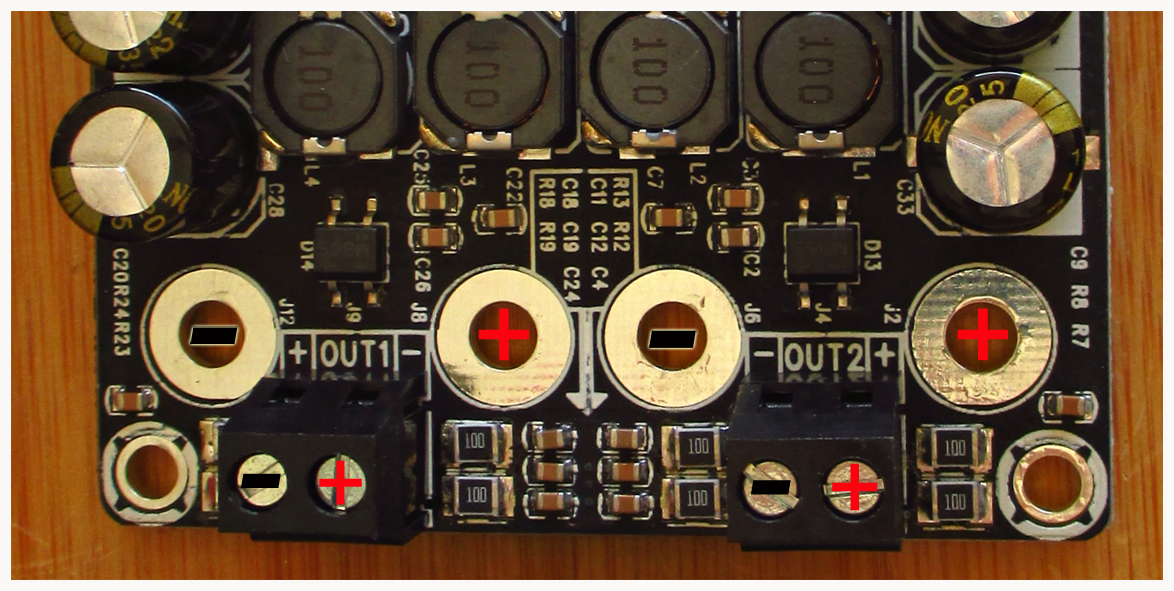
I just don't get it, Sure is not here from yesterday and kind of reputable firm, why would they make such a terrible mistake and mixed up connections? Is there anyone of you who could write and tell them that? 😕
Sure Electronics usually simplifies circuits and doesn't bother with for example excessive distortion occuring because of that. On these last two, tpa3110 and tpa3116 they seem to have added a lot of parts, partscount is much higher then competitors, so not typical Sure Electronics I would say.
Do they now also care more about outputsignal, not to make mixup mistake? They still sell several unstable other amps which they simplified🙂
Looks like you have absolute phase wrong here, see positive outputs from bridge rectifiers. But there also seems to be a via next to positive output bridge rectifier OUT2, does bottom side show anything? Or from outputpins from these bridge rectifiers signal goes straight to output terminals?
How about that new 3110, +/- output from rectifiers differs from standard tpa3110 +--+ too, so could be wrong after all? I believe I read new 3110 had grounded negatives?

I may have absolute phase inverted in that image, but I don't think so. I mainly wanted to show how to prevent being "out of phase".
The new version of the Sure tpa3110 does not have grounded negatives at the output, it is BTL as usual and is "in phase" with +,-,-,+ .
.
Sure Electronics usually simplifies circuits and doesn't bother with for example excessive distortion occuring because of that. On these last two, tpa3110 and tpa3116 they seem to have added a lot of parts, partscount is much higher then competitors, so not typical Sure Electronics I would say.
Do they now also care more about outputsignal, not to make mixup mistake? They still sell several unstable other amps which they simplified🙂
Yes, to me - that 3110, on sale!

I may have absolute phase inverted in that image, but I don't think so. I mainly wanted to show how to prevent being "out of phase".
The new version of the Sure tpa3110 does not have grounded negatives at the output, it is BTL as usual and is "in phase" with +,-,-,+ .
.
When AC signal is applied to bridge rectifier, no matter positive or negative, a positive signal will come out positive output side, a negative at negative output side of the bridge rectifier. Only outputs from bridge rectifiers determine + and - here (with signal applied). So were do these outputs go? For new Suretpa3110 it also looks like straight from rectifier to output, then labels on output must be wrong too. But that could easily be measured, where do the bridge rectifier outputs connect to, everything befor inputs for bridge rectifiers have become irrelevant I think, isn't that why they are used in powersupplies?
- Home
- Amplifiers
- Class D
- TPA3116D2 Amp
